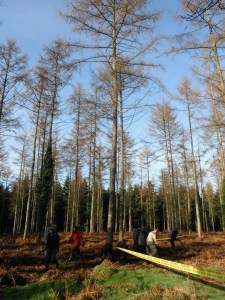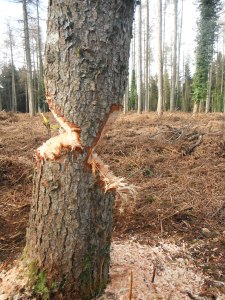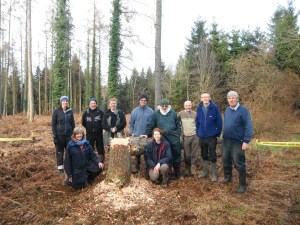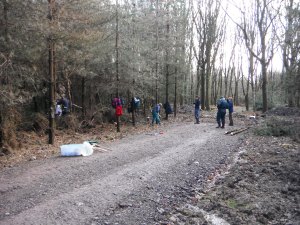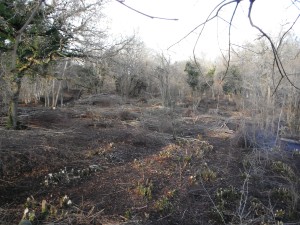Next week, we start construction of our prototype houses at Old Sarum, near Salisbury. We’re just completing the final site set-up tasks this week, so the blog is a bit quiet as delivery of portacabins and toilets isn’t that interesting! In the meantime, we thought you’d like to hear the experience so far from one of our volunteers, Nick Jones.
Reflections on Neolithic Learning
“Neolithic life in a January woodland was cold, muddy and smoky. I learned to manage the cold and the mud, but wherever I stood around the fire the smoke always got me! At least we always had hot water and mugs of tea to warm our hands on. I wondered what kind of warming brew the Beaker folk put in their beakers.
I volunteered for the Neolithic Houses Project because I knew it would be a wonderful learning opportunity. I often take clients to Avebury and Stonehenge, and we walk through the landscapes sharing thoughts and questions. It is intriguing to think that the people who created these extraordinary places were just like us – just as intelligent, just as ingenious, just as ordinary – just living in a completely different context. It is easy to admire their monuments but hard to imagine the everydayness of life in the Neolithic.
I joined the project in January, and spent a week gathering building materials. In March and April I will be involved in the construction of prototypes at Old Sarum (I can’t wait!). Nobody knows what Neolithic houses looked like – archaeologists found post holes, floors, fire pits etc at Durrington Walls, but no trace remains of walls or roofs – so anything above ground level will educated guess-work. One educated guess is that the spacing between the post holes suggests that the walls were made of seven year old Hazel coppice.
Garston Wood, near Sixpenny Handley in Dorset, has been coppiced for hundreds of years, and it has a suitable crop of seven year old hazel. I learned that the growths are called ‘rods’ and the stumps they sprout from are ‘stools’. Woodland management objectives can also affect how they grow – eg management for biodiversity retains large trees, and the shade from their canopies forces the rods to bend towards the light. We needed rods as straight as possible. Another thing that affects the rods is deer rubbing their antlers against them. This strips the bark and makes the rods harder to bend and weave between the upright posts.
We began coppicing with modern tools – bowsaws and ‘loppers’ – cutting and trimming the rods and tying them into bundles of twenty. After three days we had gathered over 3,000 rods – sufficient to build the prototypes. In the context of my modern life, I found coppicing quite therapeutic. But then I wondered whether, by Neolithic standards, this meant I wasn’t working hard enough!
“I bet you won’t be using flint axes!” taunted one of my more skeptical friends. So it was very exciting to do just that. We worked with a variety of axe shapes, monitoring how they/we performed and trying to work out the best ways of using them. We measured the circumference of each rod, recorded how long it took to cut, and how many blows of the axe were needed.
I soon learned that axe blades easily fall out of their wooden shafts. This was mostly to do with my incompetence, but the blades must have been tied, wedged or glued in some way. So we also began to record the number of ‘axe repairs’. James, our resident ‘axe-repair-man’, put them back together and knapped the blades sharp again when they broke.
James also gave a fascinating demonstration of axe-making. Knapping flint is difficult and dangerous, I learned. The Flint flakes are very sharp, so James wore safety goggles and the rest of us stood well back. I wondered whether Neolithic axe-makers managed to protect their eyes. If not, I reasoned, there must have been a lot of one-eyed Neolithic flint knappers. I came away with a box of razor-sharp flakes (c. late January, 2013AD) which have already been put to use. The teenage son of one of my clients used one to slice up a lunch menu in The Barge at Honeystreet!
I learned that the adze would have been useless for cutting rods, but it can be used for trimming twigs. And I learned that the effectiveness of flint axes generally depends on:
- the sharpness, or apex, of the blade
- the curvature of the blade (a flat blade does not slide off the rod)
- the security of the blade in the handle
- the length and weight of the handle
- the angle of blade relative to the handle
- the angle/accuracy/force/frequency of the blows
- the use of an ‘anvil’ (a log placed behind the rod)
I also mused that, if there was such a thing a Neolithic National Curriculum, it probably included:
- Traditional survival skills, including hunting and gathering
- Modern farming and food-growing skills,
- Herd-management and flock-watching
- Fire-lighting/management, including tinder and kindling storage
- Cooking and smoke evasion
- Cold and mud management
- Tool-making/using skills, including knapping/polishing/grinding/wielding
- Shelter-building, including coppicing, wattling, daubing and thatching
And then I remembered that the Scouts, Woodcraft Folk, Forest Schools etc are still keeping these skills alive today!
The learning goes way beyond the specific activities of the project. The volunteers bring a wide range of expertise, insights and enthusiasms that are shared informally during the day. And since my week in the woods l have been able to tap into the expertise of some of the people I met by email – not very Neolithic, I know!
Finally, it must be said that the learning potential of this project is greatly enhanced by its leadership. Luke Winter was hewn out of English Oak just for the job, but more importantly, the Ancient Technology Centre at Cranborne, which Luke leads, has learning at its heart. This is the kind of centre for outdoor and environmental education that all young people should have access to. Dorset should be very proud of it, and those teachers and pupils lucky enough to use it will know how valuable it is in bringing history to life.”

